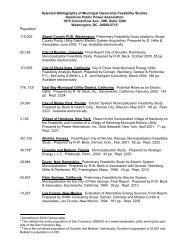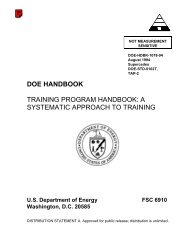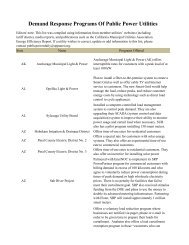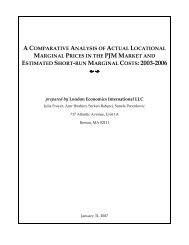Safeguarding Classified and Sensitive But Unclassified Information ...
Safeguarding Classified and Sensitive But Unclassified Information ...
Safeguarding Classified and Sensitive But Unclassified Information ...
You also want an ePaper? Increase the reach of your titles
YUMPU automatically turns print PDFs into web optimized ePapers that Google loves.
SECTION I:<br />
<strong>Safeguarding</strong> <strong>Classified</strong> National Security <strong>Information</strong><br />
<strong>Classified</strong> National Security <strong>Information</strong><br />
The classification process is based on requirements set forth in a Presidential Executive Order.<br />
The current Executive Order governing the classification system is Executive Order 12958, as<br />
amended, “<strong>Classified</strong> National Security <strong>Information</strong>,” March 2003 (hereafter referred to as the<br />
“Order”). The Order prescribes a uniform system for classifying, safeguarding, <strong>and</strong> declassifying<br />
national security information, including information relating to defense against transnational<br />
terrorism. The Order also assigns responsibility for implementation of the classified national<br />
security information program, in consultation with the Assistant to the President for National<br />
Security Affairs, to the <strong>Information</strong> Security Oversight Office (ISOO). In fulfilling this<br />
responsibility, ISOO publishes program regulations <strong>and</strong> directives for implementation of the<br />
Order. One such regulation is 32 CFR Part 2001/2004, “<strong>Classified</strong> National Security <strong>Information</strong><br />
Directive No. 1.” ISOO Directive No. 1 further defines <strong>and</strong> interprets the requirements set forth in<br />
the Order <strong>and</strong> provides instructions on implementation <strong>and</strong> management of a classification<br />
management program.<br />
Additionally, the basis for determining eligibility for access to classified information is also<br />
governed by Presidential Executive Order <strong>and</strong> is set forth in Executive Order 12968, “Access to<br />
<strong>Classified</strong> <strong>Information</strong>.”<br />
What is <strong>Classified</strong> National Security <strong>Information</strong><br />
<strong>Classified</strong> information is information that has been determined by a delegated official within the<br />
Executive Branch of the Federal Government to require protection because its release or<br />
disclosure could cause damage to the national security. Delegated officials make a<br />
determination on classification based on the st<strong>and</strong>ards <strong>and</strong> criteria cited in the Order.<br />
Classification Levels<br />
When a determination is made that information will be classified it is assigned one of three levels<br />
of classification. The level assigned is based on the potential damage to national security that<br />
could result should the information be released. The three levels of classification <strong>and</strong> their<br />
definitions are:<br />
• TOP SECRET - information which, if disclosed without authorization, could reasonably be<br />
expected to cause exceptionally grave damage to the national security.<br />
• SECRET - information which, if disclosed without authorization, could reasonably be<br />
expected to cause serious damage to the national security.<br />
• CONFIDENTIAL - information which, if disclosed without authorization, could reasonably<br />
be expected to cause damage to the national security.<br />
Other terms or phrases, such as ‘‘Secret <strong>Sensitive</strong>,’’ ‘‘Agency Confidential,’’ “Colorado Secret,”<br />
“New York Confidential,” “Law Enforcement Secret,” etc., shall NOT be used in conjunction with<br />
the classification levels above to identify classified national security information. Although the<br />
use of such markings may reflect a level of sensitivity applicable within the respective jurisdiction,<br />
information that is marked in such a manner shall not fall under the purview of the Order <strong>and</strong> thus<br />
shall not be treated in the same manner or be afforded the same legal protections afforded<br />
6

















